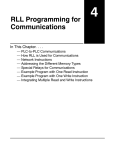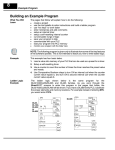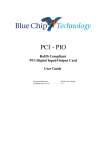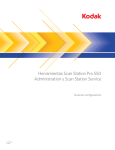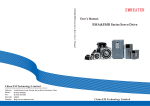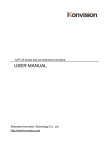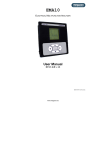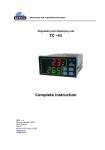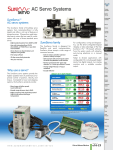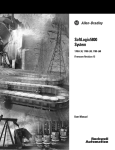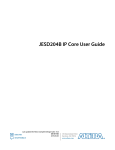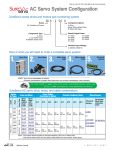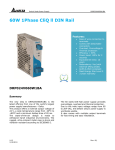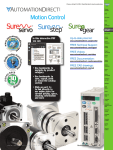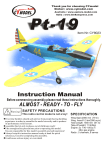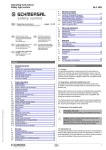Download AN-SERV-005 - AutomationDirect Technical Support
Transcript
Application Note AN-SERV-005 THIS INFORMATION PROVIDED BY AUTOMATIONDIRECT.COM TECHNICAL SUPPORT IS SUPPLIED "AS IS", WITHOUT ANY GUARANTEE OF ANY KIND. These documents are provided by our technical support department to assist others. We do not guarantee that the data is suitable for your particular application, nor we assume any responsibility for them in your application. PRODUCT FAMILY: SureServo Number: AN-SERV-005 Subject: Sureservo position with incremental position Date issued: Nov-18-2007 Revision: First edition In this example we will control the position of a rotary table that test widgets. In this example, we will determine the kinematics of the movement, the sizing of the servo motor and discuss some design considerations and we will show how to wire the servo drive to the PLC DL06. We will show the detailed wiring of the drive, the PLC program code and the servo drive parameter values; at the end we suggest actions to tune the servo. The control will be done with a C-more panel See the following diagram to understand the concept. Device The rotary table rotates 18 steps in only one direction to complete a total revolution, that is, rotates 20 degrees in the circle per each step; every time the table stops, a device is loaded into the table by operators, do some adjustments and then, when the conditions are set, the new motion is initiated. Let’s assume that the motion of every step occurs in 3 seconds. In this case, the total time for the 18 steps is 3x18= 54 seconds; The rest of the time is the time allowed for loading the air brakes into the rotating table. The time to load and unload the devices is about 25 seconds. Friction torque on the rotary table is 10 N-m, obtained empirically The inertia of the rotary table is 130 Kg-m2 including the widgets. j: ml/App notes/AN-SERV-005 1 Application Note AN-SERV-005 Kinematic studies Let’s consider one motion in the time of 3 seconds. We will consider a speed trapezoidal profile of 1.25 second acceleration, 0.5 second constant speed and 1.25 seconds for deceleration. See the planned motion trapezoidal profile below: What is the maximum speed that the rotary table will develop? If the angle is 20 degrees, then the maximum speed on the trapezoidal profile is determined by 20/1.75 = 11.428 deg/s or 11.428/360 = 0.03175 rev/s or 1.905 rpm or even in in radians, 11.428/360*2*π= 0.19945 rad/s approximately. The speed is really very slow: Let’s estimate that the servo motor could run up to a rated speed to 3000 rpm. We will do later some calculations to define the proper motor to be used here. If the rotary table rotates at the maximum speed of 1.905 rpm, the ratio could be up to 3000 rpm /1.905 rpm = 1574:1 A selection of a gearhead with a bigger ratio, will be useful to increase the torque to the load and also reduce the reflected inertia and reach a inertia ratio close to the ideal ratio in the range 10:1 or smaller. However, practical gear head sizes do not go above a ratio 512 :1. Dynamics Let’s do some torque calculations to size the motor. The dynamic torque will be given by the well known formula Tm -Tr = Jxdω/dt. The static torque is given by the frictions in the gear reducer and the rotary table. We know that the inertia of the rotary table is 130 Kg-m2 ; it is important to check that the dynamical forces will be below the available motor torque. For this specific case, we do not know for now the inertia of the motor and the gear reducer at this time. We will calculate the torque needed to move the rotary table and then we will decide what motor and gear head to use. The acceleration dω/dt is calculated by knowing that the ramp to go to the maximum speed is 1.25 second, per the figure above, and the maximum speed is 0.19945 rad/s; that is, the acceleration dω/dt is 0.15956 rad/s2. The dynamic torque on the rotary table shaft while accelerating is then T = Jxdω/dt = 130 [Kg-m2]x0.17453 [rad/s2]= 20.74 [N-m]. 2 Application Note AN-SERV-005 Let’s add the friction torque: If 10 N-m is considered on the load side, we will have a total torque during acceleration, of 30.74 N-m. The result when decelerating is -20.74 + 10 N-m = -10.74 [N-m]. Let’s select a right angle gear head from Neugart USA, type PLS70, that has at least a torque output of 37 N-m, with the ratio 8:1 with some margin. There is a trade off between the higher ratio and the torque available. In this case, the torque on the motor side would be 37/8= 4.625 [N-m] at efficiency of 100%. This takes us to a large motor, such is the SVM-210. Let’s increase the ratio to make it 64:1. In this case would be 37/64 = 0.578 N-m. The motor would be SVL-202. This motor SVL-202 has a rated torque of 0.64 N-m. Notice that, if the reducer is selected with a ratio of about 120 :1 or more, the motor will go to higher speeds with lower power (or equivalent torque). This exercise is left to the reader. The corresponding 20 degrees will correspond to 20x64 degrees or 1280 degrees, that corresponds to approximately 12890/360= 3 revolutions and 5555 fractions of a revolution. This is the angle to move for one step. This can be treated as an increment, which is constant. Notice that there is an small error due to approximation on the completion of one table revolution (3.5555 revolutions x18 steps=63.998 revs and not 64 revolutions). In this assumption, the 200 Watt sureservo motor could do the job, if the efficiency were 100%, which is not the case. We may adjust the motor, if necessary, after redoing calculations to include the inertias. In this case we could have an available continuous torque of 0.64 [N-m]x32x0.94 (efficiency)=38.5 [N-m], slightly above the the gearbox rated torque of 37 [N-m]. For this specific case, we the inertia of the motor is 0.18x10-4 Kg-m2 and the gear reducer inertia is 0.000102x10-4 kg-m2. Let’s now calculate the inertia referred to the motor side: Motor inertia = 0.180 x10-4 kg-m2 Gear inertia = 0.0001 x10-4 kg-m2 Coupling (estimated) = 0.050 x 10-4 kg-m2 Rotary table inertia/ratio2= = 130/642 Total inertia referred to motor = 317.38 x10-4 kg-m2 = 317.61x10-4 Kg-m2 The acceleration referred to the motor side is 10.212 rad/s2 (0.15956 rad/s2x64). The dynamic torque on the motor side is T = Jxdω/dt/η = 0.3243 [N-m]. Let’s add the friction torque: If 10 N-m is considered on the load side, we will have a friction torque on the motor side of 10/64/0.92 = 0.1698 [N-m] and the total torque during acceleration, is 0.4941N-m (on the load side is 31.624 N-m). The result when decelerating is -0.3243 +0.1698 N-m = -0.1545 [N-m]. On the load side is -9.888 N-m. Note that the addition of the motor and gearhead inertia was not significant in this case. The motor torque when at steady speed is 0.1698 [N-m], referred to the motor side, which is insignificant in this example. The load side reflect to 10.867 N-m./ 3 Application Note AN-SERV-005 The maximum speed that the servomotor will run will be 1.905x64 = 121.92 rpm. A load torque/time chart is shown below: Control criteria The next step will be to define the PLC control. See the figure below to follow the explanation on the next description: PBA1 - PBA2 20 degrees Home sensor Loading point PBB1 - PBB2 Unloading point Touch panel for operation There are 2 operators that are loading and unloading the pieces; they have a button close to the panel to authorize the next move, when the air brake has been loaded or unloaded,respectively. This is a touch panel of the type C-more . The pushbuttons are activated by the operators, for safety reasons, to give the permissive to start the next step cycle It is necessary to have a means to return to Home, in case there is a power shutdown during the operation, to define the proper initial position. The operation mode will be incremental mode with registers (Pr) Parameter P1-01 should be 101. There are other options not described here. By the requirements of the control, the PLC and the panel should know at any time the step that the table is located. This can be done with a simple counter, as explained later. 4 Application Note AN-SERV-005 The sequence of operation will be the following: A - When the control is powered up, first the PLC turns on and this will, by logic and a contactor, turn on the the servo drive, then the servo is enabled. B - The operator should generate a command to Search Home, with the digital input DI2, arbitrarily defined, from the panel; the parameter P2-11 should be 127; the servo is enabled with DI1. The Home position is determined by a proximity sensor located in DI3, defined with parameter P2-12 as 124. The mechanical zero is different from the sensor position. C - A position counter CT0, arbitrarily defined, will keep the position number. When the PLC is energized, the counter should be reset and the count will be 0. When the Home completed output signal is generated (defined as DO3 arbitrarily), the counter CT0 will increment the count to 1. This would allow the operators to load the untested piece (and unload the tested one, if there is one there) and for safety reasons, they should press pushbuttons to acknowledge the completion of the loading and unloading. This is one criteria. The code can be done differently if desired. D - The operators are ready in about 25 seconds or less. Let’s define the input of these pushbuttons X7, arbitrarily defined. E - When both acknowledgements occur, the PLC can generate the trigger to move the rotary table one step, The increment will be defined in P1-15 and P1-16, being P1-15 3 revolutions and P1-16 5555 counts. The trigger to move command will be defined in DI5, with parameter P2-13 set as 108. F - The servo will execute the move and then, when completed the move, it will turn on the At position output, that arbitrarily will be D04. The counter CT0 will increment the count to 2 with this. This would allow the operators to load the untested piece (and unload the tested one, if there). The operators are again ready in about 25 seconds. They may complete the actions before this time. Notice that this action is the same as the sequence C. And then the sequence will continue on the same way until a complete table rotation has been done. At this time, the counter can be reset. It might exist an offset due to the errors in calculations. The step 9 will be incremented in other slightly different increment to compensate the offset errors caused by calculation and keep the 18 steps exactly at 360 degrees. The cycle can be repeated as many times as necessary. Let’s expand on the errors of the calculation. The total counts for a complete rotary table revolution are 64 revolutions when there is a gear reducer of ratio 64:1; also, we have seen that every move will be done with 3 revolutions and 5555 counts. Let’s see what is the addition of all the moves: 3x18 steps gives 54 revolutions; 0.5555x18 gives 9.999 revolutions. That is, at the end of the 18 steps, there is a total of 63.999 revolutions and then an error of 64 -63.9999 or 0.0001 revolutions. This can be compensated in several ways, and one of them is to add another increment in any of the steps, to reach exactly 64 revolutions when the rotary table makes one complete revolution. 5 Application Note AN-SERV-005 That is, on step 9 we will add an increment of 3 revolutions and 5556 counts, this can be selected with a position select 0 PLC output digital output to change in this case the parameters P1-17 and P1-18, using a digital; input on the servo drive. There is no need to use MODBUS communications here with this control criteria, even though this is other option. General control diagram The control system can be comprised of the Sureservo drive, the PLC and the accessories such as the thumbs pushbuttons (to acknowledge that the operators are with the hands free), the home sensor, a proximity switch etc. See the following diagram to see the relationship among the various devices. Touch screen panel PLC DL06 ZIP link 230 Volt, single phase Rotary table Home sensor Operator’s pushbuttons servomotor 6 Servo Drive Application Note AN-SERV-005 Wiring between PLC and servo drive See on diagram below the selection of the functions and the corresponding outputs: The C-more panel has been selected to start the system as well as generate the Home search. The operators acknowledgement and the stop are hardwired. X2 will receive the signal from the servo drive to report Home completed and X3 will receive the signal from the servo drive to report At position. Additionally, the home sensor will be wired directly to the digital input DI3. In the diagram below are shown the control connections between the drive and the PLC, necessary to make the system work as required. MCCB Servo Drive MC 230 VAC Single phase or Three phase 50/60 Hz R S T L1 L2 D0-06DD1 CN1 +V C2 Y10 Internally Supplied 12Vdc VCC Servo power C3 User supplied 24 VDC CN2 V-REF GND T-REF GND PULL HI VDD Internally Supplied 24 VDC CN1 COM+ COMY11 Servo Enable 101 Y12 Home search 127 Home sensor + Y14 Pos select 0 111 Y15 Trigger 108 C0 SVC-PFL-0X0 Power Cable Set P D C U V W FG Servo Motor Encoder A /A B /B Z /Z +5V GND SVC-EFL-010 Encoder Cable Set DI1DI2DI3DI4DI5CN1 DI6DI7DI8- X5 Servo ready X1 At Zero speed X2 Home completed X3 At Position X4 Fault CN1 CN1 DO1+ DO1DO2+ DO2DO3+ DO3DO4+ DO4DO5+ DO5- CN3 (FG) X6 Power ON PBA1 PBA2 PBB1 PBB2 X7 E-STOP X12 PORT 2 TOUCH PANEL 7 Application Note AN-SERV-005 PLC and C-more touch panel programming The servo drive has to be programmed to follow the criteria defined. The maximum speed is defined on parameter P1-55; the acceleration time and deceleration time defined on parameters P1-34 and P1-35 are defined based on this speed. the speed is defined in units of rpm. In this case I would recommend to use 122 on the parameter P1-55 and 1.25 seconds on P1-34 and P1-35. P1-36 can be set to 10 or 20 to make a slight s-curve. P1-47 is the configuration for the Home search procedure. When the parameter setting is completed, it is necessary to remove the control power of the servo drive for a couple of seconds, to allow the saving the parameters into the drive (This is true for any parameter marked with 3 in user manual). In order to check that the drive has the proper setting on all the parameters, we recommend to print the parameters with the help of the Sureservo Pro software. A list of parameters is shown at the end of this document. The C-more panel has the following objets (See the figure below) : C113 C114 - A button Search home, associated to C113. The signal C113 will turn on every time the pushbutton is touched. - A button Start indexing, associated to C114. The signal C114 will turn on every time the pushbutton is touched. - A numeric display “Step #”, associated to the memory V1000, which is the current value of the counter CT0, - An indicator of Power ON or not, associated to the PLC output Y10. Power On is true when the output Y10 is ON. -An indicator of “Servo ready” or Servo not ready”, associated to X5. Servo ready is true when X5 is ON. - An indicator of At zero speed or not, associated to X1. At zero Speed is true when 8 Application Note AN-SERV-005 X1 is ON. - An indicator of Home completed or not, associated to X2. Home completed is true when X2 is ON. - An indicator of At position or not, associated to X3. The servo output signal At position is true when X3 is ON. - 5 indicators of the stages, associated to S0 to S6. The next step is to create the PLC program code. We decided to use stage programming in this case. See on the next section details of the code that will be programmed into the PLC. PLC programming explanation Stage 0 - At PLC power up: The first PLC scan or the return to Stage 0 will load a value of K0 to CTA0 (Basically the counter counts are reset to zero). As long as no jumps to other stages occur, this stage will keep C0-C17 and PLC outputs Y10-Y17 reset. This is a safety feature. When X6 (The selector switch to give the signal power ON) becomes TRUE, then, there is a jump to Stage 1 "Power ON" Stage 1- At start we SET Y10 "Servo Power" and Y11"Servo Enable" (Y10 and Y 11 turn on). Stage 1 will monitor various inputs to determine where program control will JUMP to. IF C113 (Search Home button on the touch screen panel) goes TRUE, then there is a jump to S2 "Home Stage" IF X2 (Homing completed) AND C114 (Start indexing button on the touch screen panel) are TRUE, then there is a jump to S3 "Run Stage" IF X12(Stop All PB) is FALSE then there is a jump to ISG 0 "Initial Stage" Stage 2-When S2 "Home Stage" is active the on delay timer T5 (Home Trigger Duration) is enabled. IF the stage S2 is TRUE AND the timer done bit T5 is FALSE, then turn on Output Y12 "Home Command". IF the timer done bit T5 is TRUE AND X2 (Homing completed) are TRUE , then there is a jump to Stage 1 "Power up" IF X12 (Stop All PB) is FALSE, there is a jump to Stage ISG 0 "Initial Stage". Stage 3-IF the count on the counter CT0 is CTA0 = 9, then SET the output Y14 (Turn ON Position Command Select 0). This will call Position 2 from the Servo. Position 2 has the offset necessary to make an exact 360 degree revolution. IF the count on the counter CT0 is CTA0 < > 9, then RST Y14 (Turn off Position Command Select 0) . 9 Application Note AN-SERV-005 IF X7 (Operator Start) AND X1(At zero speed) are TRUE, then there is a jump to Stage S4 "Advance 1 stage" IF X12 (Stop All PB) is FALSE THEN there is a jump to Stage ISG 0 "Initial Stage". Stage 4-IF the stage S4 is TRUE start the timer T6 " Trigger Command Duration". When S4 "Power On" is TRUE AND T6 is FALSE, then SET the PLC output Y16 "Trigger Command". IF CT0 "Index Counter" is TRUE, THEN, OUT C20 "Index Counter Reset". IF S4 AND X3 (At Position) are TRUE, THEN increment count in CT0 "Index Counter",IF C20 "Index Counter Reset" is TRUE, THEN, RST CT0 (Resets index counter). IF the timer done bit T6 "Trigger Command Duration" is TRUE, THEN RST Y16 "Trigger Command"(Turn OFF Y16). In normal Indexing Operation, the program will be toggling back and forth between stage 1 (Power On), then Stage 3, to check the count and define the increment to be used and stage 4. This represents Stage 1 "Power ON Stage" going thru the Operator signal X7 to start the force to go to Stage 3. Stage 3 defines the increment and then jumps to Stage 4. When in Stage 4, the output Y16 is active for the time defined in T6, the actual Servo signal to move, and move completion. When the move has been confirmed, Stage 4 will jump back to Stage 1 and wait for the next operator signal on X7. Startup procedures The program has to be tested in conjunction with the servo drive. The recommended steps are: a - Test the operation of the drive with a basic jog command. No PLC has been connected b - Connect the servo enable and test the operation of the PLC, when connected to the drive c -Connect all the other servo inputs and test the operation of home search. You can monitor the servo with the help of the Sureservo Pro software. d - Test the outputs of the drive. e - Make a complete sequence, running the 18 steps. The count at the end of one rotary revolution should be 64 revolutions on the Sureservo drive.. f - Tune the drive, if necessary. The load/motor inertias ratio is about 1700 in this case but the motor is not performing too sharp in this example. The tuning can be done with the help of the SureServo Pro software: The standard white cable SVC-PCCFG-CBL is used to connect the PC with the servo. Create a new configuration, give a name, reset the parameters to default, setting 10 on parameter P2-08, and use the parameters defined earlier: For this action, go to the menu Utilities>Current config>Print current config. The tuning of the system can be done with any of the methods offered by the drive. 10 Application Note AN-SERV-005 The task here is to move the load without overshoots, from the home position to all the positions. In this case, only one position tuning may be needed because the other positions are basically the same movement. Finally, document all the project for future troubleshooting and housekeeping,. Also, create an operating manual for the operators, that do not have to understand all the details, but they have to understand what makes every action they may generate. Finally, make backups of the programs. The servo should be connected to the load in normal condition.The first attempt to tune the system might result in a behavior as that shown in the figure below. This is an extreme case.The target of the tuning should result in a behavior similar to as the following figure: 11 Application Note AN-SERV-005 Ladder program ISG Initial Stage after PLC powerup. INITIAL STAGE S0 At first scan, reset Index Counter to "0". Accomplished by LD K0 to CTA0. _FirstScan SP0 LD 2 K0 Initial Stage after PLC powerup. INITIAL STAGE S0 OUT Step position CTA0 As long as Initial Stage ( ISG 0 ) is active, keep Coils and Outputs "Reset" Latches when SureServo is at Zero Speed ( X1 ). Mov Started Coil C0 C17 RST Initial Stage after PLC powerup. INITIAL STAGE S0 3 This is the external contactor supplying power to SureServo. SERVO POWER Y10 Y17 RST External Control Power or System Power input. MCR X6 STOP ALL PB X12 4 Control Power is Active, POWER ON S1 JMP SG Control Power is Active, POWER ON S1 This rung turns on Y0 ( the contactor providing power to the SureServo drive ) and Y1 (Servo Enable signal to DI 1 on drive). Control Power is Active, POWER ON S1 6 This is the external contactor supplying power to SureServo. SERVO POWER Y10 SET This is the signal to Digital Input 1 on SureServo SERVO ENABLE Y11 SET Starts the HOME STAGE (SG 2), which initiates and monitors the Homing Sequence of the SureServo. This is the signal to Digital Input 2 on SureServo ( Home Trigger ). HOME PB C113 7 12 Homing Sequence operation HOME STG S2 JMP Application Note AN-SERV-005 Ladder program continued Starts the RUN STAGE ( SG2 ) HOMING CMPLT X2 This stage defines the increment INCREMENT STG S3 JMP START INDEX PB C114 8 Resets Index Counter (CT 0 ) Index Cntr Rst C20 SET Initial Stage after PLC powerup. INITIAL STAGE S0 JMP STOP ALL PB X12 9 Starts the ADVANCE 1 STATION STAGE ( SG 4) STOP ALL PB X12 C10 Operator Start X7 This is the signal to Digital Input 2 on SureServo ( Home Trigger ). HOME PB C113 10 This stage defines the increment INCREMENT STG S3 JMP SG Homing Sequence operation HOME STG S2 Sends 0.3 sec signal from Y2 ( Home Command ) to Digital Input #2 ( Home Trigger ) on SureServo. Homing Sequence operation HOME STG S2 TMR Home Trigger Signal duration ( 0.3 sec ) Home Trig Dur T5 12 K3 Homing Sequence operation HOME STG S2 Home Trigger Signal duration ( 0.3 sec ) Home Trig Dur T5 13 HOME COMMAND Y12 OUT When X2 is true( HOMING COMPLETE, signal comes from Digital Output 3 - HOMING COMPLETE ). Stage will JUMP back to Stage 1. Home Trigger Signal duration ( 0.3 sec ) Home Trig Dur T5 14 STOP ALL PB X12 15 HOMING CMPLT X2 Control Power is Active, POWER ON S1 JMP Initial Stage after PLC powerup. INITIAL STAGE S0 JMP SG This stage defines the increment INCREMENT STG S3 13 Application Note AN-SERV-005 Ladder program continued This rung monitors the value in Counter 0 ( CT 0 ), and when equal to 9, activates Y4, which sends signal to Digital Input 4 on SureServo. This selects Position 2 Command (P1.17 ,1.18 and P2.37 ). This Position Command has the calculated OFFSET value that makes sure the Load ( Index Table ) will move a full 360 degrees. Step position CTA0 K9 17 Step position CTA0 K9 18 Digital Input 4 on SureServo POS CMD SLCT 0 Y14 SET Digital Input 4 on SureServo POS CMD SLCT 0 Y14 RST Operator PB'S must both be made for the duration of 0.5 seconds in this example. Operator Start X7 Digital Output 2 from SureServo triggers this input that the SureServo is stopped. AT ZERO SPEED X1 19 This stage defines the increment INCREMENT STG S3 Advance 1 station ADV 1 STG S4 JMP Resets Index Counter (CT 0 ) Index Cntr Rst C20 RST 20 Initial Stage after PLC powerup. INITIAL STAGE S0 JMP STOP ALL PB X12 21 SG Advance 1 station ADV 1 STG S4 TMR ADVANCE 1 STATION TIMER ADV 1 STA TMR T6 Advance 1 station ADV 1 STG S4 23 K3 Advance 1 station ADV 1 STG S4 24 18 station Index Table Counter. INDEX CNTR CT0 25 14 ADVANCE 1 STATION TIMER ADV 1 STA TMR T6 Digital Input 5 on SureServo TRIGGER COMMAND Y16 OUT Resets Index Counter (CT 0 ) Index Cntr Rst C20 OUT Application Note AN-SERV-005 Ladder program continued 11/19/2007 06 Advance 1 station ADV 1 STG S4 Digital Output 4 from SureServo triggers this input that the SureServo is "At Position". AT POSITION X3 CNT 18 station Index Table Counter. INDEX CNTR CT0 26 Resets Index Counter (CT 0 ) Index Cntr Rst C20 Advance 1 station ADV 1 STG S4 27 STOP ALL PB X12 28 29 revision serv 005 K18 ADVANCE 1 STATION TIMER ADV 1 STA TMR T6 Digital Output 2 from SureServo triggers this input that the SureServo is stopped. AT ZERO SPEED X1 Digital Output 4 from SureServo triggers this input that the SureServo is "At Position". AT POSITION X3 Control Power is Active, POWER ON S1 JMP Initial Stage after PLC powerup. INITIAL STAGE S0 JMP END 9 Application Note AN-SERV-005 Automation Direct SureServo PRO Drives Configuration Report Report Generated: 10/9/2007 6:38:41 PM Config Name: AN-SERV-005 Servo Config.ssc Motor Code: 11 Rev: 2.001 Parameter --------- ----- P0.00 - Software Version 2001 P0.01 - Drive Fault Code 0 P0.02 - Drive Status (Front panel display) 0 P0.03 - Analog Monitor Outputs 1 P0.04 - Status Monitor 1 0 P0.05 - Status Monitor 0 P0.06 - Status Monitor 3 0 P0.07 - Status Monitor 4 0 P0.08 - Status Monitor 5 0 P1.00 - External Pulse Input Type 2 P1.01 - Control Mode and Output Direction 1 P1.02 - Speed and Torque Limit 0 P1.03 - Output Polarity Setting 0 P1.04 - Analog Monitor Output Scaling 1 (CH1) 100 P1.05 - Analog Monitor Output Scaling 2 (CH2) 100 P1.06 - Analog Velocity Command Low-pass Filter 0 P1.07 - Analog Torque Command Low-pass Filter 0 P1.08 - Position Command Low-pass Filter 0 P1.09 - Preset Velocity Command / Limit 1 100 P1.10 - Preset Velocity Command / Limit 2 200 P1.11 - Preset Velocity Command / Limit 3 300 P1.12 - Preset Torque Command / Limit 1 100 P1.13 - Preset Torque Command / Limit 2 100 P1.14 - Preset Torque Command / Limit 3 100 P1.15 - Position 1 Command (Revolutions) P1.16 - Position 1 Command (Counts) P1.17 - Position 2 Command (Revolutions) P1.18 - Position 2 Command (Counts) 16 Value 3 5555 3 5556 P1.19 - Position 3 Command (Revolutions) 0 P1.20 - Position 3 Command (Counts) 0 P1.21 - Position 4 Command (Revolutions) 0 Application Note AN-SERV-005 P1.22 - Position 4 Command (Counts) 0 P1.23 - Position 5 Command (Revolutions) 0 P1.24 - Position 5 Command (Counts) 0 P1.25 - Position 6 Command (Revolutions) 0 P1.26 - Position 6 Command (Counts) 0 P1.27 - Position 7 Command (Revolutions) 0 P1.28 - Position 7 Command (Counts) 0 P1.29 - Position 8 Command (Revolutions) 0 P1.30 - Position 8 Command (Counts) 0 P1.31 - Motor Code 11 P1.32 - Motor Stop Mode Selection 0 P1.33 - Position Control Mode (Internal Indexer) 1 P1.34 - Acceleration Time (Internal Indexer) 1250 P1.35 - Deceleration Time (Internal Indexer) 1250 P1.36 - Accel / Decel S-Curve 10 P1.37 - Inertia Mismatch Ratio 1761 P1.38 - Zero Speed Output Threshold 10 P1.39 - Target Speed Output Threshold 3000 P1.40 - Max Analog Velocity Cmd or Velocity Limit 3000 P1.41 - Max Analog Torque Cmd or Torque Limit 100 P1.42 - On Delay Time of Electromagnetic Brake 20 P1.43 - Off Delay Time of Electromagnetic Brake 20 P1.44 - Electronic Gear Numerator 1 1 P1.45 - Electronic Gear Denominator 1 P1.46 - Encoder Output Scaling Factor 1 P1.47 - Homing Mode 222 P1.48 - Homing Speed 1 Fast Search Speed 60 P1.49 - Homing Speed 2 Creep Speed 30 P1.50 - Home Position Offset (Revolutions) -3 P1.51 - Home Position Offset (Counts) 0 P1.52 - Regenerative Resistor Value 40 P1.53 - Regenerative Resistor Capacity 60 P1.54 - In Position Window 100 P1.55 - Maximum Speed Limit 122 P2.00 - Proportional Position Loop Gain (KPP) P2.01 - Position Loop Gain Boost P2.02 - Position Feed Forward Gain (KFF) P2.03 - Smoothing Constant of Position Feed Forward Gain 35 100 5000 5 17 Application Note AN-SERV-005 P2.04 - Velocity Loop Proportional Gain (KVP) 500 P2.05 - Velocity Loop Gain Boost 100 P2.06 - Velocity Loop Integral Compensation (KVI) 100 P2.07 - Velocity Feed Forward Gain (KVF) 0 P2.08 - Factory Defaults and Security 0 P2.09 - Bounce Filter 2 P2.10 - Digital Input Terminal 1 (DI1) 101 P2.11 - Digital Input Terminal 2 (DI2) 127 P2.12 - Digital Input Terminal 3 (DI3) 124 P2.13 - Digital Input Terminal 4 (DI4) 111 P2.14 - Digital Input Terminal 5 (DI5) 0 P2.15 - Digital Input Terminal 6 (DI6) 108 P2.16 - Digital Input Terminal 7 (DI7) 0 P2.17 - Digital Input Terminal 8 (DI8) 0 P2.18 - Digital Output Terminal 1 (DO1) 101 P2.19 - Digital Output Terminal 2 (DO2) 103 P2.20 - Digital Output Terminal 3 (DO3) 109 P2.21 - Digital Output Terminal 4 (DO4) 105 P2.22 - Digital Output Terminal 5 (DO5) 107 P2.23 - Notch Filter (Resonance Suppression) P2.24 - Notch Filter Attenuation (Resonance Suppression) 0 P2.25 - Low-pass Filter (Resonance Suppression) 2 P2.26 - External Anti-Interference Gain 0 P2.27 - Gain Boost Control 0 P2.28 - Gain Boost Switching Time P2.29 - Gain Boost Switching Condition P2.30 - Auxiliary Function P2.31 - Auto and Easy Tuning Mode Response Level 10 10000 0 68 P2.32 - Tuning Mode 4 P2.33 - Reserved 0 P2.34 - Overspeed Fault Threshold P2.35 - Position Deviation Fault Window 18 1000 5000 30000 P2.36 - Position 1 Velocity 122 P2.37 - Position 2 Velocity 122 P2.38 - Position 3 Velocity 1000 P2.39 - Position 4 Velocity 1000 P2.40 - Position 5 Velocity 1000 P2.41 - Position 6 Velocity 1000 Application Note AN-SERV-005 P2.42 - Position 7 Velocity 1000 P2.43 - Position 8 Velocity 1000 P2.44 - Digital Output Mode 0 P2.45 - Index Mode Output Signal Delay Time 1 P2.46 - Index Mode Stations 6 P2.47 - Position Deviation Clear Delay Time 0 P2.48 - Backlash Compensation (Index Mode) 0 P2.49 - Jitter Suppression 0 P2.50 - Clear Position Mode 0 P2.51 - Servo Enable Command 0 P2.52 - Dwell Time 1 - Auto Index Mode 0 P2.53 - Dwell Time 2 - Auto Index Mode 0 P2.54 - Dwell Time 3 - Auto Index Mode 0 P2.55 - Dwell Time 4 - Auto Index Mode 0 P2.56 - Dwell Time 5 - Auto Index Mode 0 P2.57 - Dwell Time 6 - Auto Index Mode 0 P2.58 - Dwell Time 7 - Auto Index Mode 0 P2.59 - Dwell Time 8 - Auto Index Mode 0 P2.60 - Electronic Gear Numerator 2 1 P2.61 - Electronic Gear Numerator 3 1 P2.62 - Electronic Gear Numerator 4 1 P2.63 - Velocity and Position Deviation Scaling Factor 0 P3.00 - Communication Address 2 P3.01 - Transmission Speed 3 P3.02 - Communication Protocol 8 P3.03 - Communication Fault Action 0 P3.04 - Communication Watchdog Time Out 0 P3.05 - Communication Selection 0 P3.06 - Reserved 0 P3.07 - Communication Response Delay Time 0 P4.00 - Fault Record - Most recent (N) 14 P4.01 - Fault Record (N-1) 14 P4.02 - Fault Record (N-2) 9 P4.03 - Fault Record (N-3) 9 P4.04 - Fault Record (N-4) 9 P4.05 - JOG Function 160 P4.06 - Force Outputs Command 0 P4.07 - Input Status 5 19 Application Note AN-SERV-005 P4.08 - Reserved P4.09 - Output Status 20 8 11 P4.22 - Analog Velocity Input Offset 0 P4.23 - Analog Torque Input Offset 0




















